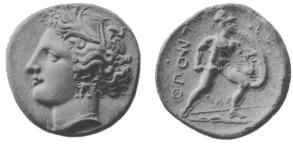
FIG. 190.



[British Museum Catalogue of Greek Coins, Central Greece, by B. V. Head 1884]
The Eastern Locrians, sometimes called Ηοιοι, sometimes Opuntii, after their chief town Opus, and sometimes Hypocnemidii (later Epic- nemidii) from their geographical position at the foot of Mt. Cnemis, struck no coins which can be attributed to an earlier date than about B.C. 400, nor was it until after the peace of Antalcidas, which enacted that all towns in European Greece και μικρας και μεγαλας αυτονομουσ ειναι (Xen. Hell. v. 1, 3. 31) that the capital Opus began to place her own name on the money.
The weight standard of the Locrian money is the Aeginetic, and the following are the chief types:—

| Head of goddess crowned with leaves, copied from the famous Syracusan dekadrachm by Euainetos (B.C. 405-367), (Fig. 190; cf. Fig. 98; cf. Photiades Cat., 344). | ΟΠΟΝΤΙΟΝ The Locrian Ajax, the son of Oïleus, naked, but armed with helmet, sword, and shield, advancing to the fight, accompanied on one variety by his name ΑΙΑΣ; copied from the Syracusan type of ΛΕΥΚΑΣΠΙΣ1 (pp. 175 and 178 supra).
AR Staters, Drachms, and ½ Drachms.
|
| ΟΠΟΝ Amphora. [B. M. C., Cent. Gr., Pl. I. 2, and varieties in N. C., 1895, 270.] | Star (ηωος αστηρ, the badge of the eastern Locrians. Cf. Strab., p. 416).
AR Obols.
|
| Head of Athena. | ΟΠΟΝΤΙΩΝ Grapes. Æ .5
|
After the battle of Chaeroneia, B.C. 338, it is probable that Opus, like Thebes, fell under the displeasure of Philip, and that, as in Boeotia the right of issuing silver was transferred from Thebes to the Boeotians, so also in Locris it was transferred from Opus to the Locrians collectively. The coins of the Locrians, which appear to be subsequent to the battle of Chaeroneia, resemble for the most part in their types those already described, although they are distinctly later in style, but instead of ΟΠΟΝΤΙΩΝ they bear the legends ΛΟΚΡΩΝ ΥΠΟΚ (in mon.), ΛΟΚΡ, ΛΟ, or ΛΟΚΡ ΕΠΙΚΝΑ (B. M. C., Cent. Gr., Pl. II, and Photiades Cat., 351).
1 I am inclined to think that these types were designed for the Opuntians at the Syracusan mint, and that the dies (for the first issue at any rate) were executed there. At a later period the Aetolians also appear to have had recourse to the die-engravers of Syracuse for their first gold coins. (See supra, p. 334.)
Under Macedonian rule from circa. B.C. 300 there is no reason to suppose that any coins were struck in Locris; but when Flamininus (B.C. 197) restored freedom to all the cities of Greece, Opus began once more to strike bronze coins with the old types, but reading ΟΠΟΥΝΤΙΩΝ in place of ΟΠΟΝΤΙΩΝ. This coinage came to an end in B.C. 146 (B.M.C., Cent. Gr., Pl. II. 9).
Under the empire Opus again enjoyed the right of coinage, but for a short period only, during the reigns of Galba and Otho, sometimes with magistrate’s name, ЄΠΙ ΚΛΑΥ[ΔΙΟΥ] CЄΡΑΠΙΩΝΟC. On some of these coins of Imperial times are the heads of Hades and Persephone, and on the reverses a warrior (perhaps Opous) standing. For other varieties of Locrian coins see B. M. C., Cent. Gr., Pls. I and II, and Imhoof, Mon. gr., p. 148.
Scarpheia was an ancient Locrian city mentioned by Homer (Il. ii. 532).
| Female head. | ΣΚΑΡΦΕΩΝ The Locrian Ajax in fighting attitude. Æ .65
|
| Head of Athena. [B. M. C., Cent. Gr., Pl. II. 13.] | ΣΚΑΡΦΕΩΝ Hermes standing. Æ .8
|
For some others see Prokesch, Ined., 1854, Pl. II. 44, and Margaritis Cat., Pl. I. 22.
Thronium. (Leake, Northern Greece, ii. 177.)
| Bearded head of Centaur or Seilenos. [B. M. C., Cent. Gr., Pl. II. 14.] | ΘRΟΝΙ Greave (κνημις) in incuse square. AR Obol.
|
On this coin, which is one of the earliest struck in Locris, the reverse type contains an allusion to the Cnemis range of mountains, from which the people of Eastern Locris derived their surname.
In the time of the Aetolian League, B.C. 279-168, Thronium struck bronze coins with Aetolian types.
| Head of Apollo. [B. M. C., Cent. Gr., Pl. II. 15.] | ΘΡΟΝΙΕΩΝ Spear-head and jaw-bone of boar; symbol, grapes. Æ .7
|
Amphissa, which had been destroyed by Philip of Macedon, B.C. 338, was afterwards restored and became a populous place.
| Head of Apollo laur. | ΑΜΦΙΣΣΕΩΝ Spear-head and jaw-bone of Kalydonian boar; symbols, star and grapes. Æ .7
|
Oeantheia. The only known coin of this city shows by its shape that it belongs to the time of the Aetolian league.
| Head of Apollo laur. [Imhoof, Mon. gr., p. 147.] | ΟΙΑΝΘΕΩΝ Spear-head. Æ .7
|